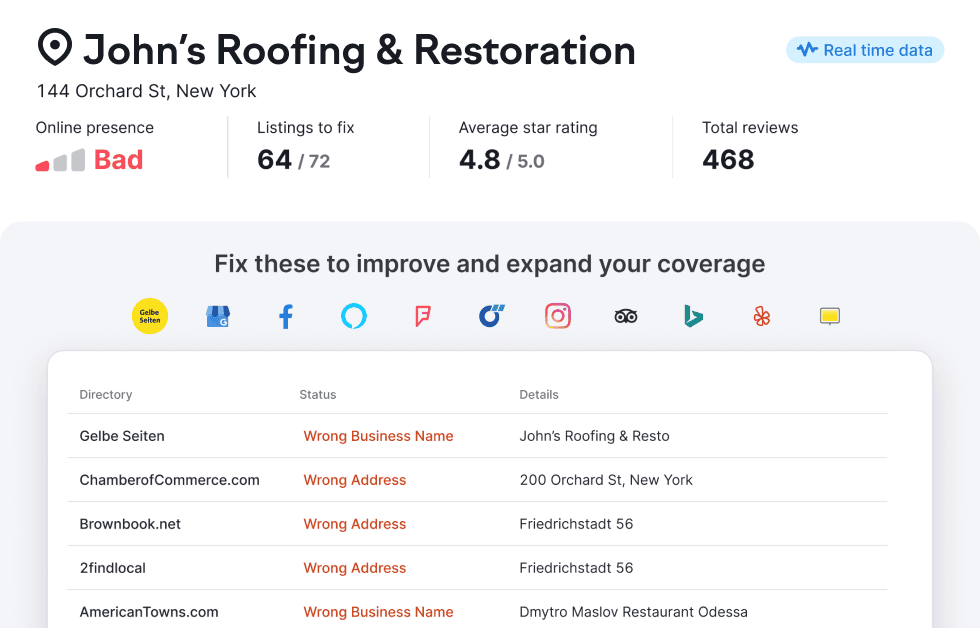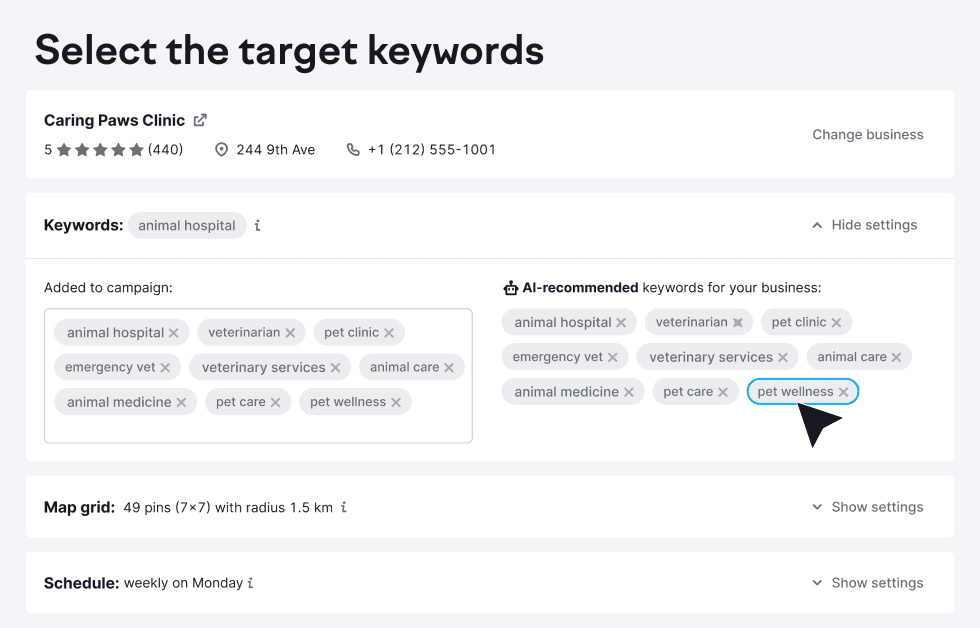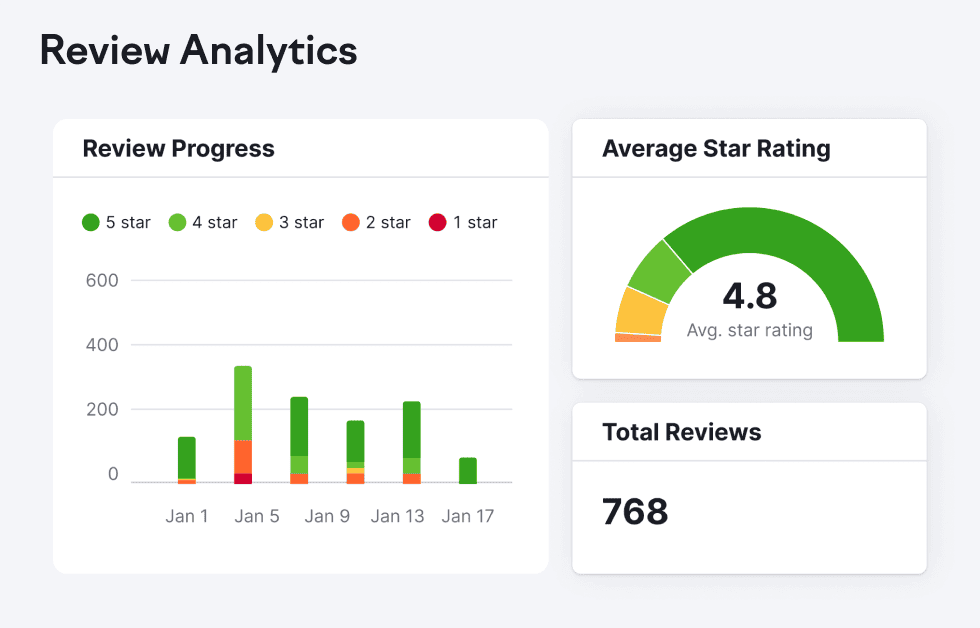- A local SEO audit helps you identify strengths and weaknesses in your local business’ search marketing strategy.
- Your audit should cover your Google Business Profile, local business website, and online listings.
- Semrush Local's Listing Management tool makes it easy to update online listings, monitor reviews, and track Google Maps rankings.
What is a local SEO audit?
A local SEO audit is an analysis of your local business’ organic (unpaid) visibility in search engine results pages and all the elements that contribute to its performance. This includes your Google Business Profile, website, and online business listings. Performing a local SEO audit helps you identify weaknesses and opportunities in your search marketing strategy, so you can find ways to improve your rankings and get more local business. Focus on Google Search and Google Maps performance, as these are two of the biggest search channels for local businesses. Here’s how to do a local SEO audit, step by step.
How to audit your Google Business Profile
Your Business Profile is your local business listing on Google. It’s what appears in map results on Google Maps and Google Search. Below is an example of a “local pack” or “map pack” in Google Search, which typically includes three profile snippets. Clicking “More places” opens the Local Finder, which has additional business listings.  Auditing and improving your Business Profile can help it rank higher when people search for relevant products or services in your area. It can also lead to a better conversion rate —a higher percentage of viewers becoming customers—because it equips them with key information they need to make a purchase decision. If you haven’t already, add your business to Google and complete the location verification process. This allows you to edit your listing. Then, sign into Google Business Profile and start your audit:
Auditing and improving your Business Profile can help it rank higher when people search for relevant products or services in your area. It can also lead to a better conversion rate —a higher percentage of viewers becoming customers—because it equips them with key information they need to make a purchase decision. If you haven’t already, add your business to Google and complete the location verification process. This allows you to edit your listing. Then, sign into Google Business Profile and start your audit:
- Check that your business information is present and correct
- Consider updating your photos and videos
- Respond to reviews (and report any that violate Google’s guidelines )
- Respond to unanswered questions in the Q&A section To see the search queries your Business Profile ranks for, go to the “Insights” report and review the “Searches breakdown.”
If you want to identify keywords with the best potential for your business (i.e., target keywords), you’ll need to perform local keyword research .
This tells you what queries prospects use and in what volumes. It can also show you search terms that competitors rank for, but you don’t.
Track your rankings for target keywords in nearby search locations using Semrush Local's Map Rank Tracker tool . The tool produces a heamtap report that shows your positions in Google Maps depending on where your customers are when they search online.
How to audit your local business website
When someone enters a relevant keyword into Google Search, you want your website to rank in the organic results. The higher the better. Exposure in any other search engine results page features ( SERP features ), such as the “People also ask” box, can also drive valuable traffic. When you perform a local SEO audit on your site, you can identify issues holding back your rankings. And find other ways to improve. 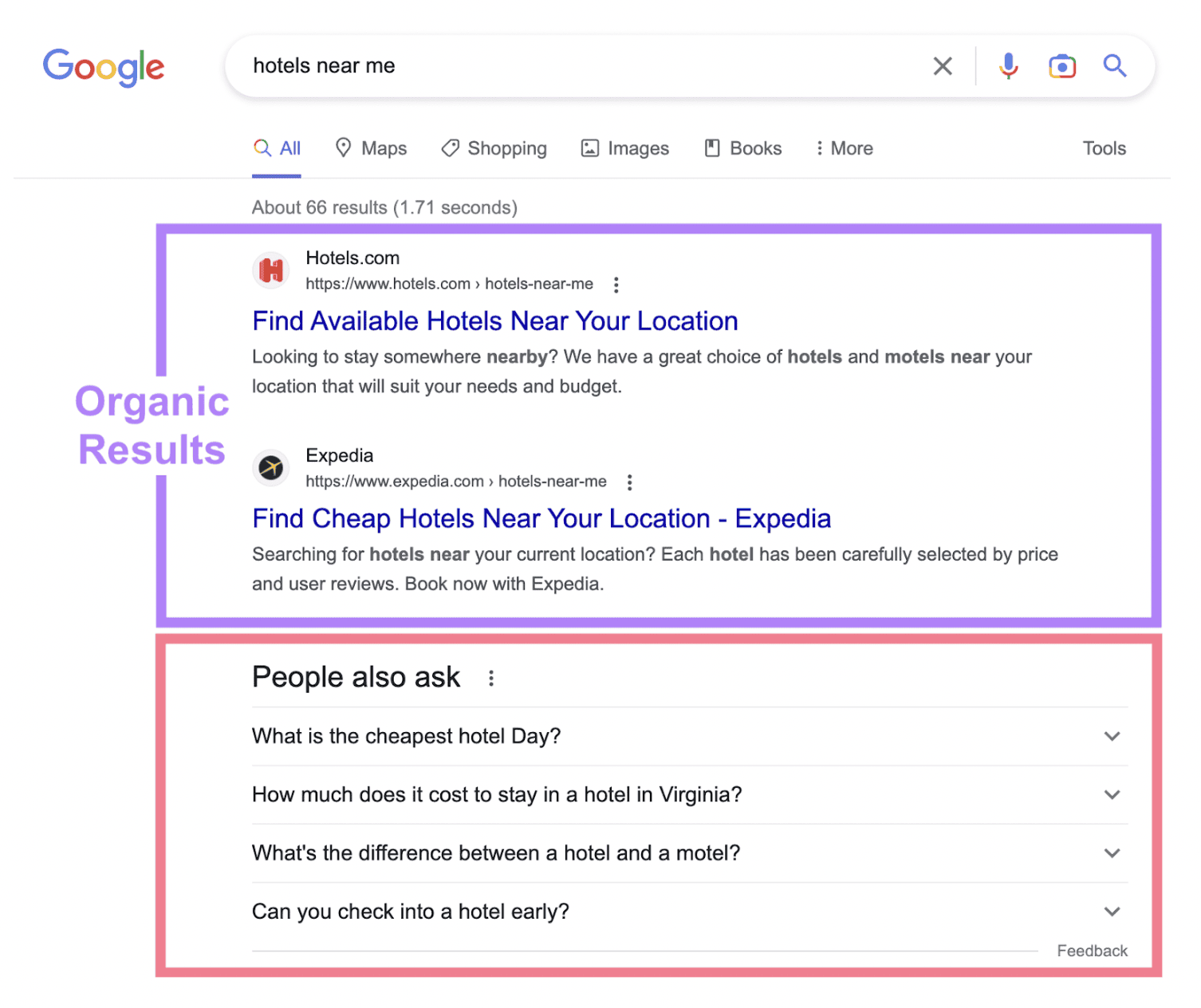
Check your website rankings
Generally, it’s quicker and easier to improve existing keyword rankings than establish new ones. Find the queries your domain already ranks for in Google Search Console . Go to the “Search results” report to see keywords and your average positions. Those ranking in positions five to 15 are generally the best candidates for improvement. 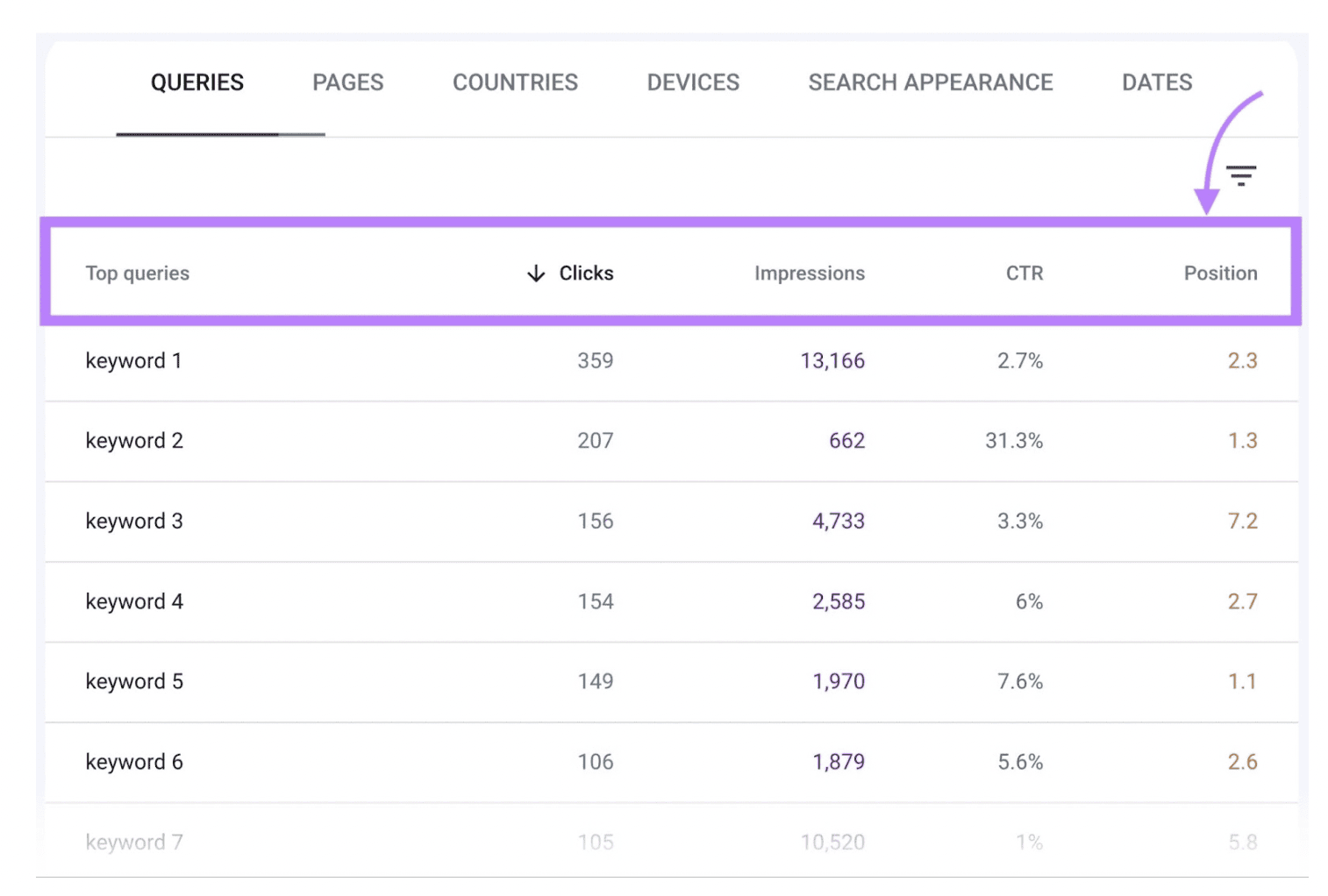 Check the “CTR” column, too. This is your click-through rate: the percentage of impressions (i.e., views of your website listing in SERPs) that resulted in clicks. A low CTR could indicate your title tag and meta description are suboptimal, as these are the details typically displayed in organic search results.
Check the “CTR” column, too. This is your click-through rate: the percentage of impressions (i.e., views of your website listing in SERPs) that resulted in clicks. A low CTR could indicate your title tag and meta description are suboptimal, as these are the details typically displayed in organic search results.  For additional insights and to measure your search visibility, add your target keywords to Semrush’s Position Tracking tool . One of the most useful metrics for keyword prioritization is “Volume,” or the average number of searches per month. You can also see whether keywords trigger any SERP features. And if so, whether your website appears.
For additional insights and to measure your search visibility, add your target keywords to Semrush’s Position Tracking tool . One of the most useful metrics for keyword prioritization is “Volume,” or the average number of searches per month. You can also see whether keywords trigger any SERP features. And if so, whether your website appears.
Get technical SEO recommendations
Technical aspects of your site, such as loading speed and mobile friendliness, affect performance in organic search. In addition to your visitors’ user experience. So, it’s important to review technical elements as part of your local SEO audit. Start by checking the following sections in Google Search Console:
- Pages: Make sure the right pages are added to the Google index - Sitemaps: Check that Google has a correct and up-to-date sitemap
- Page experience: See whether your pages deliver a good experience on mobile and desktop
- Core Web Vitals: See whether any URLs fail Core Web Vitals (metrics relating to page experience)
- Mobile usability: Note any issues related to pages’ mobile usability HTTPS: Make sure all your pages use secure HTTPS encryption
- Manual actions: Check if site rankings are affected by a Google penalty
- Security issues: Identify other security issues on your site Semrush’s Site Audit tool can help you prioritize technical SEO issues. And provides advice on why and how to fix each problem.
Review your backlink profile
Backlinks are links on other websites that point to your website, cumulatively known as your backlink profile. The quality and quantity of links in your backlink profile can have a significant impact on rankings, both positively and negatively.
So it’s important to review them in your local SEO audit. Start by looking for potentially harmful backlinks . If Google thinks your site has engaged in unethical or spammy linking practices (i.e., had links placed purely for SEO purposes) it can apply a “manual action” or “Google penalty” that harms your rankings. Find and fix potentially harmful backlinks with Semrush’s BacklinK Audit . The tool checks your backlinks for “toxic markers” and gives each one a Toxicity Score. If you want the site owner to remove the backlink, you can contact them through the platform. If unsuccessful, you can create a disavow file that asks Google to ignore the link.
Next, compare your backlink profile against your competitors’. Google treats natural or “earned” backlinks as endorsements. If a competitor has more backlinks than you—or backlinks from higher-quality sites—it can be more difficult to outrank them. Use link-building strategies to catch up. Semrush’s Backlink Analytics tool allows you to compare up to five backlink profiles simultaneously. Metrics like Authority Score give you an idea of how hard it will be to outrank your competitors. You can also look at other metrics, such as the number of referring domains, to see how you measure up.
Evaluate individual pages
To rank highly for a target keyword, you need a page that caters to the search intent behind that keyword. In other words, a page that satisfies the user’s goal when entering the keyword into Google. Understand what searchers want by looking at the top-ranking pages for your target keyword. Then, use various on-page optimization techniques to make your content more user-friendly and Google-friendly. Semrush’s On Page SEO Checker suggests page improvements based on best practices and the top 10 results for your target keywords. If you connect your Google Analytics account, the tool will even look at user experience metrics like time on page. These recommendations help you construct a page that deserves to rank well and get clicks. The tool will do the following:
- Flag technical issues with your page
- Check the quality of your title tag and meta description
- Compare your content’s length and readability against rivals’
- Show you where competitors are using keywords
- Identify backlink prospects (sites that might link to your page)
- And more
Pro tip: Use On schema to mark up your content for search engines. Google may display marked-up content (known as “structured data”) in organic results, which makes them more engaging and useful. In this example, searchers can see how many IHOP branches are in each city and go straight to the most relevant page. All thanks to the site’s use of “sitelinks” schema. 
How to audit your listings and citations
Listings or citations are online references to your local business’ name, address, and phone number (NAP). Getting featured in online directories such as Yelp and Foursquare creates more ways for prospects to find your business online. It can also increase your business’ online prominence, which can boost Business Profile and website rankings.
Plus, Google uses local listings to verify information in your Business Profile. If it finds conflicting business hours, for example, it may be less confident in your profile and less likely to display it to users. Ensure your citations are correct and consistent. You can contact listing sites directly to get your business information added or updated, but this can be time-consuming.
With Semrush’s Listing Management tool, enter your information once and it’s automatically submitted to the top directories in your country. You can even get location reports via email, which show key performance metrics. The tool also has a “Review Management” tab that brings together reviews from Google, Facebook, and other directories. As well as key metrics such as your average star rating. This makes it easier to handle customer service issues and improve your online reputation .
Manage your listings and reviews in one place with Semrush Local
Semrush Local is a must-have local SEO audit tool. It simplifies many of the trickiest steps and makes it easy to stay on top of SEO tasks as your business grows.
Keep your online listings up to date
With Listing Management, you only have to update your details once. The tool automatically submits the new information to Google Business Profile and other online directories.
Looking to perform a free local SEO audit? Enter your business name to check your local listings—no signup or credit card required.
